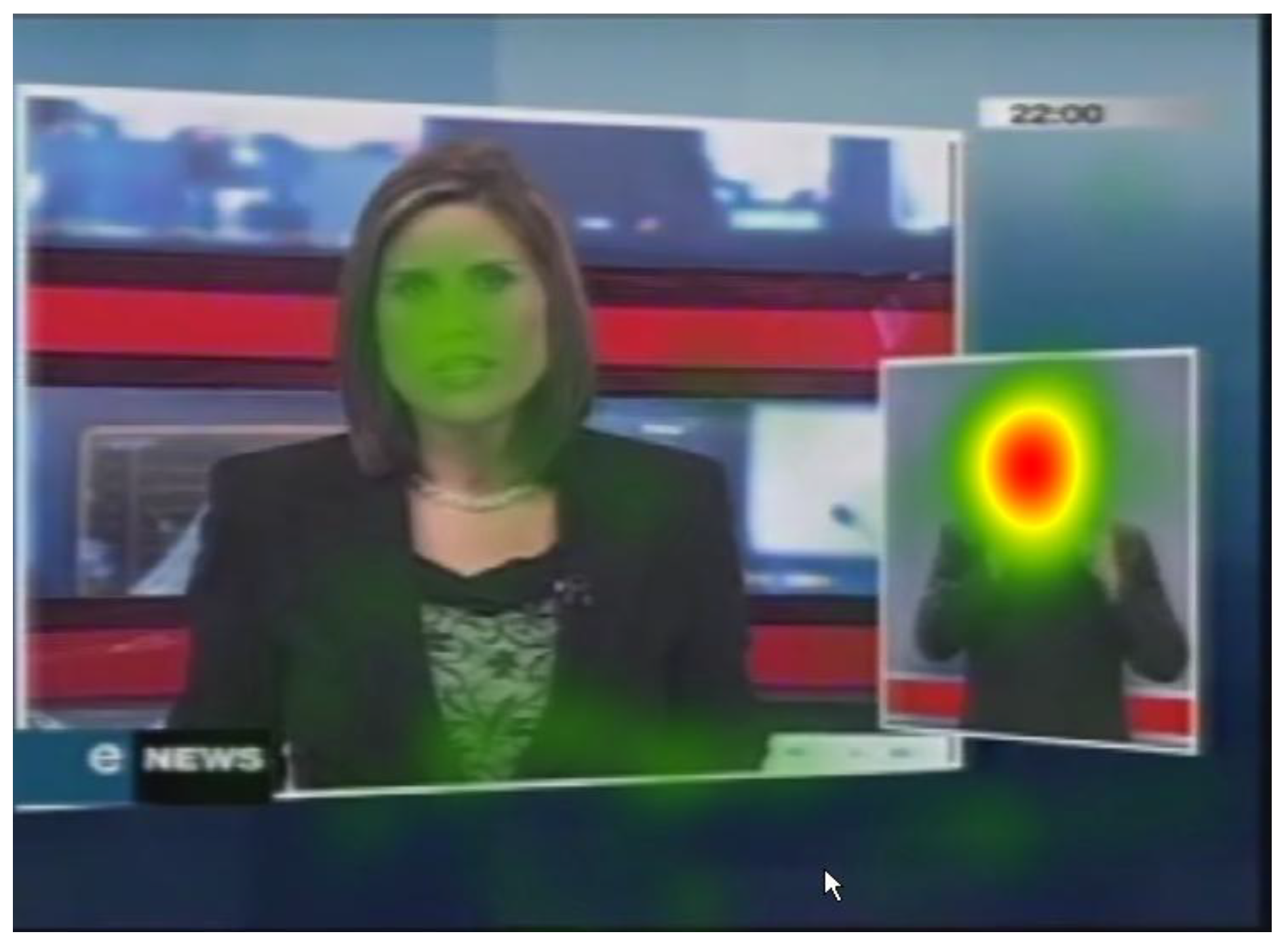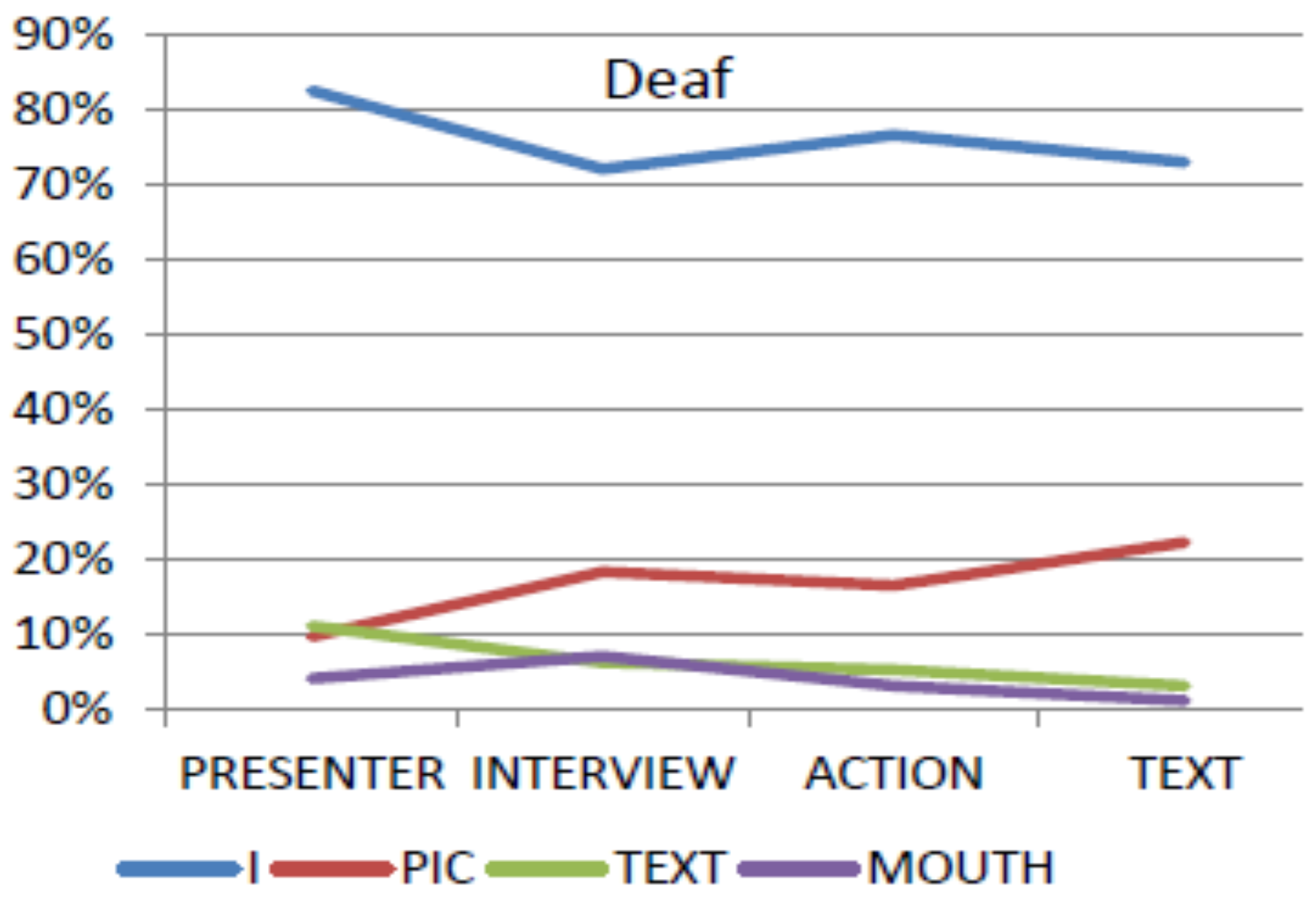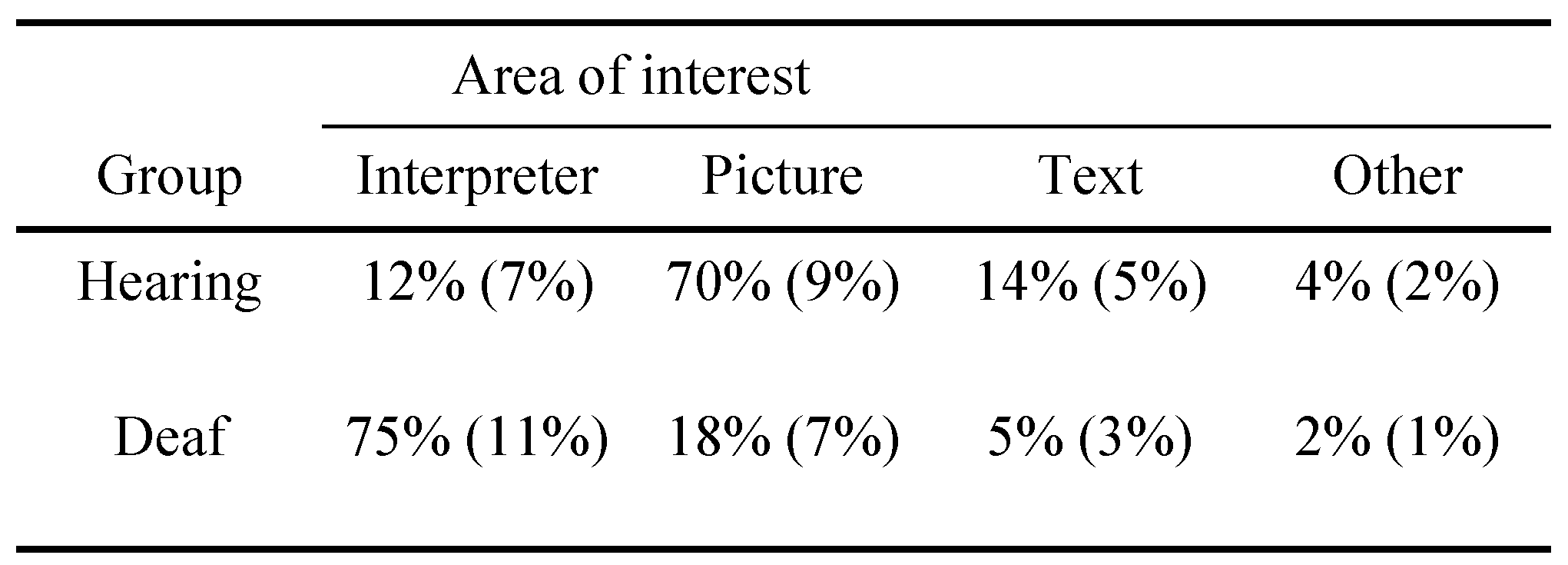Eye-Tracking Deaf and Hearing Viewing of Sign Language Interpreted News Broadcasts
Abstract
Introduction
The Deaf community
The status of South African Sign Language
The relevance of an interpreter
Interpreting versus lip-reading
Interpreting versus reading
The problem of divided attention
Method
Procedure
Content of video material.
Participants
Eye-tracking analysis
Results
Differences between deaf and hearing viewing patterns
Comprehension challenges
Content variation
Discussion
Conclusion
Acknowledgments
References
- Aarons, D., and P. Akach. 2002. Edited by R. Mesthrie. South African Sign Language: one language or many? In Language in South Africa. Cambridge: Cambridge University Press, pp. 127–147. [Google Scholar]
- Akach, P., and J. Lubbe. 2003. The giving of personal names in spoken languages and signed language – a comparison. Acta Academica Supplementum 2: 104–128. [Google Scholar] [CrossRef]
- Baaring, I. 2006. Respeaking-based online subtitling in Denmark. inTRAlinea Special edition Respeaking. http://www.intralinea.org/specials/articles/Respeaking-based_online_subtitling_in_Denmark (accessed on 27 February 2013).
- Baker-Shenk, C., and D. Cokely. 1981. American Sign Language: A teacher’s resource text on grammar and culture. Washington D.C: Gallaudet University Press. [Google Scholar]
- Bartoll, E., and A.M. Tejerina. 2010. Edited by A-Matamala and P. Orero. The positioning of subtitles for the deaf and hard of hearing. In Listening to subtitles: subtitles for the deaf and hard-of-hearing. Frankfort am Main: Peter Lang, pp. 69–86. [Google Scholar]
- British Broadcasting Company. 2009. Online subtitling editorial guidelines, V1.1. http://www.bbc.co.uk/guidelines/futuremedia/accessibility/subtitling_guidelines/online_sub-editorial-guidelines_vs1_1.pdf (accessed on 03/06/2013).
- Berke, J. 2009. Deaf community–South Africa: schools, organisations and television. http://deafness.about.com/od/internationaldeaf/a/south (accessed on 11 November 2009).
- Bidoli, C. 2009. Sign language: a newcomer to the interpreting forum. (Paper given at the International Conference on Quality in Conference Interpreting.). http://www.openstarts.units.it/dspace/bitstream/10077/2454/1/08.pdf (accessed on 21 December 2009).
- Constitution. 1996a. Constitution of the Republic of South Africa. http://www.info.gov.za/documents/constitution/1996/a108-96.pdf (accessed on 12 October 2010).
- Constitution. 1996b. Chapter 1:1-6. Founding provisions. http://www.info.gov.za/documents/constitution/1996/96cons1.htm#6 (accessed on 12 October 2010).
- DeafSA. 2012. Deaf Federation of South Africa. http://www.deafsa.co.za (accessed on 15 June 2012).
- DeafSA. 2009. Policy on the provision and regulation of South African sign language interpreters. http://www.deafsa.co.za/resources/SASLI_policy.pdf (accessed on 20 June 2012).
- DeafSA. 2008. DeafSA Constitution. http://www.deafsa.co.za/resources/Constitution.pdf (accessed on 20 June 2006).
- De Korte, T. 2006. Live inter-lingual subtitling in the Netherlands. inTRAlinea Special edition Respeaking. http://www.intralinea.org/specials/articles/Live_inter-lingual_subtitling_in_the_Netherlands (accessed on 27 February 2013).
- De Valois, R., and K. De Valois. 1990. Spatial vision. Oxford: Oxford University Press. [Google Scholar]
- Duncan, J. 1980a. The demonstration of capacity limits. Cognitive Psychology 12: 75–96. [Google Scholar] [CrossRef]
- Duncan, J. 1980b. The locus of interference in the perception of simultaneous stimuli. Psychological Review 87: 272–300. [Google Scholar] [CrossRef]
- d’Ydewalle, G., and W. De Bruycker. 2007. Eye Movements of Children and Adults While Reading Television Subtitles. European Psychologist 12, 3: 196–205. [Google Scholar] [CrossRef]
- Ganiso, M. 2012. Sign language in South Africa: language planning and policy challenges. Grahamstown: Rhodes University. Unpublished MA dissertation. [Google Scholar]
- Gile, D. 1995. Basic concepts and models for interpreter and translator training. Amsterdam & Philadelphia: John Benjamins. [Google Scholar]
- Goldberg, J., and A. Wichansky. 2003. Edited by J. Hyönä, R. Radach and H. Deubel. Eye tracking in usability evaluation: a practitioner’s guide. In The mind’s eye: cognitive and applied aspects of eye movement research. Amsterdam: Elsevier Science, pp. 493–516. [Google Scholar]
- Heap, M., and H. Morgans. 2006. Edited by B. Watermeyer, L. Swartz, T. Lorenzo, M. Schneider and M. Priestley. Language policy and SASL: interpreters in the public service. In Disability and social change: a South African agenda. Cape Town: HSRC Press, pp. 134–147. [Google Scholar]
- Higgs, C. 2006. Subtitles for the deaf and the hard of hearing on TV: legislation and practice in the UK. inTRAlinea Special edition Respeaking. http://www.intralinea.org/specials/articles/Subtitles_for_the_deaf_and_the_hard_of_hearing (accessed on 27 February 2013).
- Humphrey, J., and B. Alcorn. 1996. So you want to be an interpreter: an introduction to sign language interpreting. Amarillo, Texas: H&H Publishers. [Google Scholar]
- Jackson, D., P. Paul, and J. Smith. 1997. Prior knowledge and reading comprehension ability of deaf adolescents. Journal of Deaf Studies and Deaf Education 2, 3: 172–184. [Google Scholar] [CrossRef][Green Version]
- Jacobs, L. 1977. The efficiency of interpreting input for processing lecture information by deaf college students. Journal of Rehabilitation of the Deaf 11: 10–14. [Google Scholar]
- Jensema, C. 1998. Viewer reaction to different television captioning speeds. American Annals of the Deaf 143, 4: 318–324. [Google Scholar] [CrossRef]
- Jensema, C.J., R.S. Danturthi, and R. Burch. 2000. Time spent viewing captions on television programs. American Annals of the Deaf 145, 5: 464–468. [Google Scholar] [CrossRef] [PubMed]
- Krejtz, I., A. Szarkowska, and K. Krejtz. 2013. The effects of shot changes on eye movements in subtitling. Journal of Eye Movement Research 6, 5 3. : 1–12. [Google Scholar] [CrossRef]
- Kyle, J. 2007. Sign on television: analysis of data. Deaf Studies Trust. Available at http://stakeholers.ofcom.org.uk/binaries/consultations/signing/responses/deafst udies_annex.pdf (accessed on 12 August 2012).
- Kyle, J., and M. Harris. 2006. Concurrent correlates and predictors of reading and spelling achievement in deaf and hearing school children. Journal of Deaf Studies and Deaf Education 11, 3: 273–288. [Google Scholar] [CrossRef]
- Lambourne, A. 2006. Subtitle respeaking: a new skill for a new age. inTRAlinea Special edition Respeaking. http://www.intralinea.org/specials/articles/Subtitle_respeaking (accessed on 27 February 2013).
- Lane, H., R. Hoffmeister, and B. Bahan. 1996. Journey into the Deaf world. California: Dawnsign Press. [Google Scholar]
- Lång, J., J. Mäkisalo, T. Gowases, and S. Pietinen. 2013. Using Eye Tracking to Study the Effect of Badly Synchronized Subtitles on the Gaze Paths of Television Viewers. New Voices in Translation Studies 10: 72–86. [Google Scholar]
- Lawson, L. 2002. Edited by S. Gregory and G. Hartley. The role of sign in the structure of the Deaf community. In Constructing deafness. London: Printer Press, pp. 31–34. [Google Scholar]
- Leeson, L., and J. Saeed. 2012. Irish Sign Language: a cognitive linguistic account. Edinburgh: Edinburgh University Press. [Google Scholar]
- Lewis, M., ed. 2009. Ethnologue: Languages of the World, Sixteenth edition. Dallas, Texas: SIL International. [Google Scholar]
- Lewis, M.S., and D.W. Jackson. 2001. Television literacy. Comprehension of program content using closedcaptions for the deaf. Journal of Deaf Studies and Deaf Education 6, 1: 43–53. [Google Scholar] [CrossRef] [PubMed]
- Lombard, S. 2006. The accessibility of a written Bible versus a signed Bible for the deaf-born person with sign language as first language. Bloemfontein: University of the Free State. Unpublished MA thesis. [Google Scholar]
- Lotriet, A. 2011. Sign language interpreting in South Africa: meeting the challenges. http://criticallink.org/wp-content/uploads/2011/09/CL2_Lotriet.pdf (accessed on 30 March 2012).
- Lorenzo, L. 2010. Edited by A. Matamala and P. Orero. Criteria for elaborating subtitles for deaf and hard of hearing children in Spain: A guide of good practice. In Listening to subtitles: subtitles for the deaf and hard-ofhearing. Frankfort am Main: Peter Lang, pp. 139–148. [Google Scholar]
- Magongwa, L. 2012. The current status of South African Sign Language. Lecture given at the University of Pretoria. May 31. [Google Scholar]
- Marsh, A. 2006. Respeaking for the BBC. inTRAlinea Special edition Respeaking. http://www.intralinea.org/specials/articles/Respeaking_for_the_BBC (accessed on 27 February 2013).
- Marschark, M., R. Peterson, and E. Winston, eds. 2005. Sign language interpreting and interpreter education: directions for research and practice. Oxford & New York: Oxford University Press. [Google Scholar]
- Marschark, M., P. Sapere, C. Convertino, R. Seewagen, and H. Maltzen. 2005. Edited by M. Marschark, R. Peterson and E. Winston. Educational interpreting: access and outcomes. In Sign language interpreting and interpreter education: directions for research and practice. Oxford & New York: Oxford University Press, pp. 1–34. [Google Scholar]
- Marschark, M., P. Sapere, C. Convertino, R. Seewagen, and H. Maltzen. 2004. Comprehension of sign language interpreting: deciphering a complex task situation. Sign Language Studies 4, 4: 345–368. [Google Scholar] [CrossRef]
- Matamala, A., and P. Orero. 2010. Listening to subtitles: subtitles for the deaf and hard-of-hearing. Frankfort am Main: Peter Lang. [Google Scholar]
- Mesthrie, R. Language in South Africa. Cambridge: Cambridge University Press.
- Miller, J. 1982. Divided attention: evidence for coactivation with redundant signals. Cognitive Psychology 14, 2: 247–279. [Google Scholar] [CrossRef]
- Montero, I.C., and A.M. Soneira. 2010. Spanish deaf people as recipients of closed captioning. Edited by A. Matamala and P. Orero. In Listening to subtitles: subtitles for the deaf and hard-of-hearing. Frankfort am Main: Peter Lang, pp. 25–44. [Google Scholar]
- Morgan, R. 2001. Barriers to justice: Deaf people and the courts. Issues in Law, Race and Gender 8, Law, Race and Gender Research Unit, University of Cape Town. [Google Scholar]
- Morgan, R. 2008. Deaf me normal: Deaf South Africans tell their stories. Pretoria: Unisa Press. [Google Scholar]
- Morgan, R., and D. Aarons. 1999. How many South African sign languages are there? A sociolinguistic question. In Proceedings of the 13th World congress of the World Federation of the Deaf. Sydney: Australian Association of the Deaf, pp. 356–374. [Google Scholar]
- Napier, J., R. McKee, and D. Goswell. 2010. Sign language interpreting: theory and practice in Australia and New Zealand. NSW: Federation Press. [Google Scholar]
- [NCPPDSA]. National Council for Persons with Physical Disabilities in South Africa. 2011. Basic hints for interaction with people with hearing loss. http://www.ncppdsa.org.za (accessed on 20 September 2011).
- Nebel, K, H Weise, P. Stude, A De Greiff, H.C. Diener, and M. Keidel. 2005. On the neural basis of focused and divided attention. Cognitive Brain Research 25: 760–776. [Google Scholar] [CrossRef] [PubMed]
- Newhoudt-Druchen, W. 2006. Edited by R.L. McKee. Working together. In Proceedings of the inaugural conference of the World Association of Sign Language Interpreters. Gloucestershire: Douglas Maclean, pp. 8–11. [Google Scholar]
- Neves, J. 2008. 10 fallacies about subtitling for the d/Deaf and hard of hearing. JoSTrans 10: 128–143. http://www.jostrans.org/issue10/art_neves.pdf (accessed on 29 October 2014).
- Olivier, J. 2007. South African Sign Language. http://www.cyberserve.co.az/users/~jako/lang/signlanguage/index.htm (accessed on 12 October 2010).
- Orero, P. 2006. Real-time subtitling in Spain: an overview. inTRAlinea Special edition Respeaking. http://www.intralinea.org/specials/articles/Real-time_subtitling_in_Spain (accessed on 27 February 2013).
- Pashler, H. 1989. Dissociations and dependencies between speed and accuracy: evidence for a twocomponent theory of divided attention in simple tasks. Cognitive Psychology 21: 469–514. [Google Scholar] [CrossRef]
- Pederson, J. 2010. Audiovisual translation-in general and in Scandinavia. Perspectives 18, 1: 1–22. [Google Scholar] [CrossRef]
- Penn, C. 1992. Edited by R. Herbert. The sociolinguistics of South African Sign Language. In Language and society in Africa. Johannesburg: Witwatersrand University Press, pp. 277–284. [Google Scholar]
- Penn, C., D. Doldin, K. Landman, and J. Steenekamp. 1992. Dictionary of Southern African signs for communication with the Deaf. Pretoria: HSRC. [Google Scholar]
- Penn, C., and T. Reagan. 1994. The properties of South African Sign Language: lexical diversity and syntactic unity. Sign Language Studies 85: 319–327. [Google Scholar] [CrossRef]
- Pereira, A. 2010. Criteria for elaborating subtitles for deaf and hard of hearing adults in Spain: Description of a case study. Edited by A. Matamala and P. Orero. In Listening to subtitles: subtitles for the deaf and hard-of-hearing. Frankfurt am Main: Peter Lang, pp. 87–102. [Google Scholar]
- [PMG]. Parliamentary Monitoring Group. 2009. Language issues: proposed recognition of South African Sign Language as official language, Sepedi/Sesotho sa Leboa issues: briefings by Deaf SA, CRL Commission, Pan South African Language Board. http://www.pmg.org.za//20091113-language-issues-proposed-recognition-south-african-sign-language-official/html (accessed on 12 November 2012).
- [PMG]. Parliamentary Monitoring Group. 2007. Recognition of South African Sign Language as official language: briefing by Deaf Federation of South Africa. http://www.pmg.org.za/print/8655 (accessed on 13 November 2009).
- Posner, M. 1980. Orienting of attention. Quarterly Journal of Experimental Psychology 32, 1: 3–25. [Google Scholar] [CrossRef]
- Reagan, T. 2008. South African Sign Language and language in education policy in South Africa. Stellenbosch Papers in Linguistics 38: 165–190. [Google Scholar] [CrossRef]
- Reagan, T. 2012. Personal correspondence, 27/06/2012. [Google Scholar]
- Remael, A., and B. Van der Veer. 2006. Real-time subtitling in Flanders: needs and teaching inTRAlinea Special edition Respeaking. http://www.intralinea.org/specials/articles/Realtime_subtitling_in_Flanders_Needs_and_teaching (accessed on 27 February 2013).
- Ribas, M.A., and P. Romero Fresco. 2008. A practical proposal for the training of respeakers 1. JoSTrans 10: 106–127. http://www.jostrans.org/issue10/art_arumi.php (accessed on 29 January 2014).
- Romero Fresco, P. 2009. More haste less speed: edited versus verbatim respoken subtitles. http://webs.uvigo.es/vialjournal/pdf/Vial-2009-Article6.pdf (accessed on 29 January 2014).
- Romero Fresco, P. 2011. Quality in Respeaking: The Reception of Respoken Subtitles. http://www.respeaking.net/programme/romero.pdf (accessed on 29 January 2014).
- SADA. 2012. South African Disability Alliance: the collective voice of the disability sector in collaboration. http://www.deafsa.co.za/resources/SADA_ profile.pdf (accessed on 20 June 2012).
- Szarkowska, A., I. Krejtz, Z. Kłyszejko, and A. Wieczorek. 2011. Verbatim, standard, or edited? Reading patterns of different captioning styles among deaf, hard of hearing, and hearing viewers. American Annals of the Deaf 156, 4: 363–378. [Google Scholar] [CrossRef]
- SA Schools Act. 1996. No. 84 of 1996: South African schools act, 1996. http://www.info.gov.za/acts/1996/a84-96.pdf (accessed on 16 July 2012).
- SA Yearbook. 2009. South Africa Yearbook. Pretoria: Central Statistical Service. [Google Scholar]
- Setton, R., ed. 2011. Interpreting Chinese, interpreting China. Amsterdam & Philadelphia: John Benjamins. [Google Scholar]
- Shlesinger, M. 2000. Strategic allocation of working memory and other attentional resources in simultaneous interpreting. Ramat-Gan: Bar-Ilan University. Unpublished PhD thesis. [Google Scholar]
- Signgenius. 2009. http://www.signgenius.com/info-statistics.html (accessed on 19 December 2009).
- Spelke, E., W Hirst, and U. Neisser. 1976. Skills of divided attention. Cognition 4: 215–230. [Google Scholar] [CrossRef]
- Statistics SA. 2009. http://www.statssa.gov.za/census01/html/C2001disability.asp (accessed on 18 October 2009).
- [StatsSA] Statistics SA. 2012. Census 2011. Methodology and highlights of key results. http://www.statssa.gov.za/census2011/Products/Census2011_Methodology_and_highlight_of_key_results.p df (accessed on 18 October 2009).
- Steiner, B. 1998. Signs from the void. The comprehension and production of sign language on television. Interpreting 3, 2: 99–146. [Google Scholar] [CrossRef]
- Stone, C. 2009. Towards a Deaf translation norm. Washington, D.C.: Gallaudet University Press. [Google Scholar]
- Stratiy, A. 2005. Edited by T. Janzen. Best practices in interpreting: a Deaf community perspective. In Topics in signed languages and interpreting: theory and practice. Amsterdam & Philadelphia: John Benjamins, pp. 231–250. [Google Scholar]
- Tedstone, D., and K. Colye. 2004. Cognitive impairments in sober alcoholics: performance on selective and divided attention tasks. Drug and Alcohol Dependence 75: 277–286. [Google Scholar] [CrossRef]
- Torres, M.S., and R.H. Santana. 2005. Reading levels of Spanish deaf students. American Annals of the Deaf 150, 4: 379–387. [Google Scholar]
- Utray, F., B. Ruiz, and J.A. Moreiro. 2010. Edited by A. Matamala and P. Orero. Maximum font size for subtitles in standard definition digital television: tests for a font magnifying application. In Listening to subtitles: subtitles for the deaf and hard-of-hearing. Frankfurt am Main: Peter Lang, pp. 59–68. [Google Scholar]
- Van Herreweghe, M., and M. Vermeerbergen. 2010. Deaf perspectives on communicative practices in South Africa: institutional language policies in educational settings. Text & Talk 30, 2: 125–144. [Google Scholar]
- Vermeerbergen, M., M. Van Herreweghe, P. Akach, and E. Matabane. 2007. Constituent order in Flemish Sign Language (VGT) and South African Sign Language (SASL). Sign Language & Linguistics 10, 1: 25–54. [Google Scholar]
- Wehrmeyer, J. 2013. A critical investigation of Deaf comprehension of signed TV news interpretation. Pretoria: University of South Africa. Unpublished D. Litt. et Phil. thesis. [Google Scholar]
- Wehrmeyer, J. forthcoming. Deaf comprehension of TV sign language interpreters. Submitted to New Voices in Translation Studies.
- Xiao, X., and R. Yu. 2009. Survey on sign language interpreting in China. Interpreting 11, 2: 137–163. [Google Scholar] [CrossRef]
- Xiao, X., and R. Yu. 2011. Edited by R. Setton. Sign language interpreting in China: a survey. In Interpreting Chinese, interpreting China. Amsterdam & Philadelphia: John Benjamins, pp. 29–53. [Google Scholar]
- Xiao, X., and F. Li. 2013. Sign language interpreting on Chinese TV: a survey on user perspectives. Perspectives 21, 1: 100–116. [Google Scholar] [CrossRef]




 |
Copyright © 2014. This article is licensed under a Creative Commons Attribution 4.0 International License.
Share and Cite
Wehrmeyer, J. Eye-Tracking Deaf and Hearing Viewing of Sign Language Interpreted News Broadcasts. J. Eye Mov. Res. 2014, 7, 1-16. https://doi.org/10.16910/jemr.7.1.3
Wehrmeyer J. Eye-Tracking Deaf and Hearing Viewing of Sign Language Interpreted News Broadcasts. Journal of Eye Movement Research. 2014; 7(1):1-16. https://doi.org/10.16910/jemr.7.1.3
Chicago/Turabian StyleWehrmeyer, Jennifer. 2014. "Eye-Tracking Deaf and Hearing Viewing of Sign Language Interpreted News Broadcasts" Journal of Eye Movement Research 7, no. 1: 1-16. https://doi.org/10.16910/jemr.7.1.3
APA StyleWehrmeyer, J. (2014). Eye-Tracking Deaf and Hearing Viewing of Sign Language Interpreted News Broadcasts. Journal of Eye Movement Research, 7(1), 1-16. https://doi.org/10.16910/jemr.7.1.3



